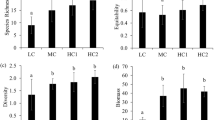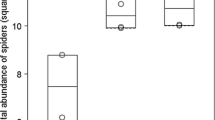Abstract
Macrophytes increase structural complexity in aquatic ecosystems and their emergent structures provide habitats for spiders. We sampled spiders in three species of macrophytes (Eichhornia azurea, Eichhornia crassipes and Limnobium laevigatum) and measured five traits indicative of structural complexity: horizontal structure, vertical structure, plant height, macrophyte richness and macrophyte biomass. We tested the hypothesis that spider density and diversity increase and guild composition changes along a gradient of structural complexity provided by macrophytes. Vertical and horizontal structure and macrophyte richness covaried with the attributes of spider assemblages. However, vertical structure was an important habitat-complexity trait because it covaried with all spider attributes investigated, positively affecting density and taxa richness and changing guild composition. Our findings suggest that the increase in macrophyte structural complexity, primarily through vertical structure, provides additional habitat and microhabitat variability. These forms of variability may increase the availability of prey and shelter and even reduce intraguild predation between spiders, thereby potentially increasing density and taxa richness. Moreover, an increase in vertical complexity provides available structures for web attachment, favoring web-building spiders and consequently affecting guild composition. Thus, habitat structure plays an important role in structuring spider assemblages and specific traits may mediate changes in particular attributes of spider assemblages.




Similar content being viewed by others
References
Abilhoa V, Vitule JRS, Bornatowski H (2010) Feeding ecology of Rivulus luelingi (Aplocheiloidei: Rivulidae) in a coastal Atlantic Rainforest stream, southern Brazil. Neotrop ichthyol 8:813–818
Akamatsu F, Toda H, Okino T (2004) Food source of riparian spiders analyzed by using stable isotope ratios. Ecol Res 19:655–662
Askenmo C, von Brömssen A, Ekman J, Jansson C (1977) Impact of some wintering birds on spider abundance in spruce. Oikos 28:90–94
Balfour RA, Rypstra AL (1998) The influence of habitat structure on spider density in a no-till soybean agroecosystem. J Arachnol 26:221–226
Beals ML (2006) Understanding community structure: a data-driven multivariate approach. Oecologia 150:484–495
Brandt Y, Lubin Y (1998) An experimental manipulation of vegetation structure: consequences for desert spiders. Isr J Zool 44:201–216
Burnham KP, Anderson DR (2002) Model selection and multimodel inference: a practical information – theoretic approach. Springer, New York
Castro A, Wise D (2009) Influence of fine wood debris on spider diversity and community structure in forest leaf litter. Biodivers Conserv 18:3705–3731
Denno RF, Mitter MS, Langellotto GA, Gratton C, Finke D (2004) Interactions between a hunting spider and a web-builder: consequences of intraguild predation and cannibalism for prey suppression. Ecol Entomol 29:566–677
Dibble ED, Killgore KJ, Harrel SL (1996) Assessment of fish plant interactions. Am Fish Soc Symp 16:357–372
Döbel HG, Denno RF, Coddington JA (1990) Spider (Araneae) community structure in an intertidal salt marsh: effects of vegetation structure and tidal flooding. Environ Entomol 19:1356–1370
Ferreira FA, Mormul RP, Thomaz SM, Pott A, Pott VJ (2011) Macrophytes in the Upper Paraná River floodplain: checklist and comparisons with other large South American wetlands. Rev Biol Trop 59:541–556
Finke DL, Denno RF (2004) Predator diversity dampens trophic cascades. Nature 429:407–410
Finke DL, Denno RF (2006) Spatial refuge from intraguild predation: implications for prey suppression and trophic cascades. Oecologia 149:265–275
Gonçalves-Souza T, Almeida-Neto M, Romero GQ (2011) Bromeliad architectural complexity and vertical distribution predict spider abundance and richness. Austral Ecology 36:476–484
Gotelli NJ, Colwell RK (2001) Quantifying biodiversity: procedures and pitfalls in the measurement and comparison of species richness. Ecol Lett 4:379–391
Gunnarsson B (1990) Structure and the abundance and size distribution of spruce-living spiders. J Anim Ecol 59:743–752
Halaj J, Ross DW, Moldenkel AR (1998) Habitat structure and prey availability as predictors of the abundance and community organization of spiders in western Oregon forest canopies. J Arachnol 26:203–220
Heck KLJ, Crowder LB (1991) Habitat structure and predator–prey interactions in vegetated aquatic systems. In: Bell SS, McCoy ED, Mushinsky HR (eds) Habitat structure: the physical arrangement of objects in space. Chapman and Hall, London, pp 281–299
Jeffries M (1993) Invertebrate colonization of artificial pondweeds of differing fractal dimension. Oikos 67:142–148
Johnson JB, Omland KS (2004) Model selection in ecology and evolution. Trends in Ecology and Evolution 19:101–108
Langellotto GA, Denno RF (2004) Responses of invertebrate natural enemies to complex-structured habitats: a meta-analytical synthesis. Oecologia 139:1–10
Langellotto GA, Denno RF (2006) Refuge from cannibalism in complex-structured habitats: implications for the accumulation of invertebrate predators. Ecol Entomol 31:575–581
Luz-Agostinho KDG, Bini LM, Fugi R, Agostinho AA, Júlio HF Jr (2006) Food spectrum and trophic structure of the ichthyofauna of Corumbá reservoir, Paraná river Basin, Brazil. Neotropical Ichthyology 4:61–68
MacArthur RH, MacArthur JW (1961) On bird species diversity. Ecology 42:594–598
Marczak LB, Richardson JS (2007) Spiders and subsidies: results from the riparian zone of a coastal temperate rainforest. J Anim Ecol 76:687–694
McCoy ED, Bell SS (1991) Habitat structure: the evolution and diversification of a complex topic. In: Bell SS, McCoy ED, Mushinsky HR (eds) Habitat structure: the physical arrangement of objects in space. Chapman and Hall, London, pp 3–27
McNett BJ, Rypstra AL (2000) Habitat selection in a large orb-weaving spider: vegetational complexity determines site selection and distribution. Ecol Entomol 25:423–432
Novakowski GC, Hahn NS, Fugi R (2008) Diet seasonality and food overlap of the fish assemblage in a pantanal pond. Neotrop ichthyol 6:567–576
Pelicice FM, Agostinho AA (2006) Feeding ecology of fishes associated with Egeria spp. patches in a tropical reservoir, Brazil. Ecology of Freshwater Fish 15:10–19
R Development Core Team (2011) R: A language and environment for statistical computing. R Foundation for Statistical Computing, Vienna, Austria. Available from: http://www.Rproject.org/
Raizer J, Amaral MEC (2001) Does the structural complexity of aquatic macrophytes explain the diversity of associated spider assemblages? J Arachnol 29:227–237
Riechert SE, Gillespie RG (1986) Habitat choice and utilization in web building spiders. In: Shear WA (ed) Spiders webs, behavior, and evolution. Stanford University Press, Stanford, pp 23–48
Robinson JV (1981) The effect of architectural variation in habitat on a spider community: an experimental field study. Ecology 62:73–80
Romero GQ, Vasconcellos-Neto J (2005) The effects of plant structure on the spatial and microspatial distribution of a bromeliad-living jumping spider (Salticidae). J Anim Ecol 74:12–21
Schaffers PA, Raemakers IP, Sýkora KV, ter Braak CJF (2008) Arthropod assemblages are best predicted by plant species composition. Ecology 89:782–794
Souza ALT, Martins RP (2005) Foliage density of branches and distribution of plant-dwelling spiders. Biotropica 37:416–420
Souza MC, Cislinski J, Romagnolo MB (1997) Levantamento florístico. In: Vazzoler AEAM, Agostinho AA, Hahn NS (eds) A planície de inundação do alto rio Paraná. EDUEM, Maringá, pp 343–368
StatSoft Inc. (2005) STATISTICA (data analysis software system), version 7.1. Available from: http://www.statsoft.com
Taniguchi H, Nakano S, Tokeshi M (2003) Influences of habitat complexity on the diversity and abundance of epiphytic invertebrates on plants. Freshwat Biol 48:718–728
Thomaz SM, Dibble E, Evangelista LR, Higuti J, Bini LM (2008) Influence of aquatic macrophyte habitat complexity on invertebrate abundance and richness in tropical lagoons. Freshw Biol 53:358–367
Tokeshi M, Arakaki S (2012) Habitat complexity in aquatic systems: fractals and beyond. Hydrobiologia. doi:10.1007/s10750-011-0832-z
Uetz GW (1991) Habitat structure and spider foraging. In: Bell SS, McCoy ED, Mushinsky HR (eds) Habitat structure: the physical arrangement of objects in space. Chapman and Hall, London, pp 325–341
Uetz GW, Halaj J, Cady AB (1999) Guild structure of spiders in major crops. J Arachnol 27:270–280
Acknowledgements
We would like to thank all our contributors and reviewers. We thank Thaísa S. Michelan, Juliana C. de Oliveira, Camila F. de Souza, Rosemara Fugi, Heloísa B. A. Evangelista, Cristiane A. Umetsu and Cássia R. Ceole for their assistance with fieldwork. We are also indebted to Sebastião Rodrigues and Alfredo Soares da Silva for field support; David Candiani, Nancy L. M. Hung, Adalberto J. dos Santos, Antônio Brescovit, Daniele Polotow Geraldo and Regiane S. Ferreira for sorting support; Katya E. Kovalenko for insightful suggestions and Luiz Carlos Gomes for statistical discussions. We additionally thank Núcleo de Pesquisas em Limnologia Ictiologia e Aquicultura for providing facilities for the development of this study. ERC is extremely grateful to ‘Coordenadoria de Aperfeicoamento de Pessoal de Nível Superior’ (CAPES) for a Master’s degree scholarship. SMT and ABB are especially thankful to the Brazilian Council of Research (CNPq) for continuous funding through Research Productivity grants.
Author information
Authors and Affiliations
Corresponding author
Electronic Supplementary Material
Below is the link to the electronic supplementary material.
ESM 1
(PDF 1005 kb)
Rights and permissions
About this article
Cite this article
Cunha, E.R., Thomaz, S.M., Mormul, R.P. et al. Macrophyte Structural Complexity Influences Spider Assemblage Attributes in Wetlands. Wetlands 32, 369–377 (2012). https://doi.org/10.1007/s13157-012-0272-1
Received:
Accepted:
Published:
Issue Date:
DOI: https://doi.org/10.1007/s13157-012-0272-1




